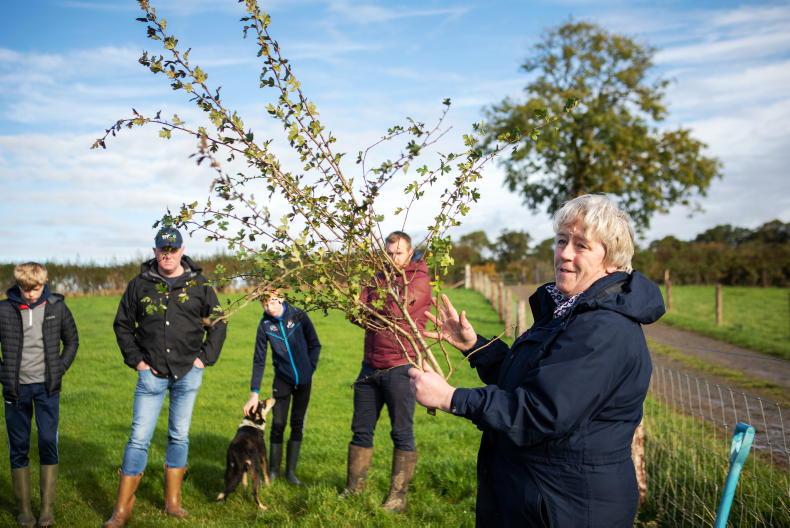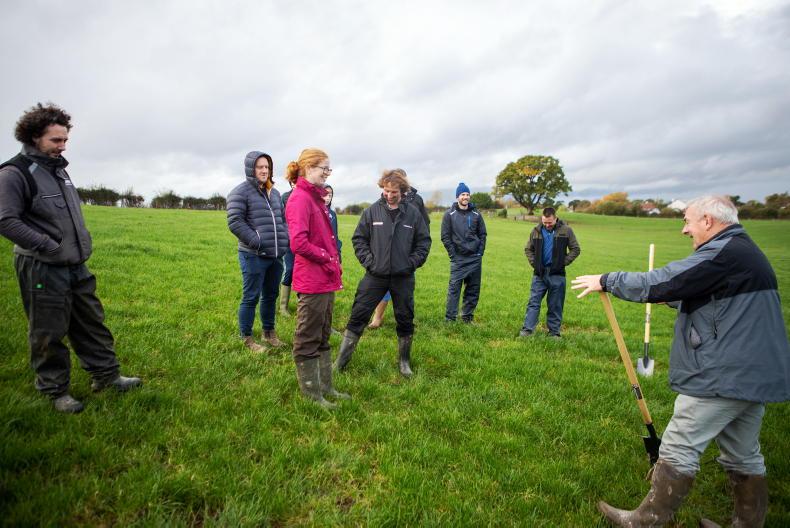Last week the Irish Farmers Journal brought together the Footprint Farmers on Tullamore Farm.
The group established earlier this year come from across the country from farms of different intensities across the beef, dairy, sheep and tillage sectors and will be working to improve the sustainability of their farms.
The new initiative will see all the farmers involved working to reduce their emissions and environmental footprint while endeavouring to increase profitability and focus on the social aspects of sustainability such as time management.
Once armed with the facts and figures, all farms will develop a plan to improve the sustainability of their business and will be advised by the Irish Farmers Journal
team
Measuring is a key part of management and profit monitors and nutrient management plans will play an important role in developing the baseline scenario for all farms. Once armed with the facts and figures, all farms will develop a plan to improve the sustainability of their business and will be advised by the Irish Farmers Journal
team.
The programme, which is supported by Macra Agricultural Skillnet, will aim to showcase the good practices taking place on farms already, while also working to make improvements from cutting back on fertiliser, to planting hedgerows to looking at animal genetics.
Carbon emissions
Each farm’s carbon footprint will be calculated and the aim will be to reduce it. As we collect data on soil carbon storage, we will also look at carbon in hedgerows and other opportunities for sequestration on farms.
Improving soil health and fertility, reducing fertiliser use, using organic manures more efficiently, planting cover crops and looking at age at slaughter and genetics are just some of the things that can be looked at when improving that footprint.
Soil testing
All farms have been soil sampled for soil pH, nitrogen, phosphorus and potassium as well as some of the other major and micronutrients. Improving fertiliser use efficiency can significantly affect profits, as well as emissions.
Soil carbon sampling has been carried out across the farms to different depths and as knowledge around soil carbon improves, the Irish Farmers Journal will work with these farms to ensure they are up to date and have the data necessary to trade that carbon.
Water quality
Water quality is another thing to examine on farms and many measures that can reduce the carbon footprint, like reducing fertiliser use, can reduce a farm’s impact on water quality. Similarly, where margins are left beside watercourses, this can be good for biodiversity.
Biodiversity
Habitats, hedgerows and the overall biodiversity of each farm will be examined in the programme and we will work with farmers to protect and improve the quality of habitats on their farms. Improving habitats can positively affect the farming system as natural predators for pests like aphids increase in numbers and pesticide usage may be reduced. Cover crops planted over winter not only provide a habitat and food for animals but provide a soil cover and take up nutrients over winter preventing loss to watercourses and can provide fodder for animals.
Steps to
sustainability
Last week the Footprint Farmers met with Catherine Keena, environmental specialist with Teagasc, and Irish Farmers Journal tillage editor Andy Doyle on Tullamore Farm to talk about biodiversity, hedgerows and soil health.

Catherine Keena of Teagasc speaking to the Footprint Farmers last week. \ Claire Nash
Top tip – hedgerows
At the beginning of her talk Catherine Keena asked everyone to do a quick sum. Take the area of your farm (owned land) and divide that area by the number of fields on your farm with a permanent boundary (hedgerow, row of trees).
Catherine noted that on some farms this figure might be 1ha, but on others it could be as high as 30ha. The magic number she explained is about 5ha. Farms should be aiming for that figure to be 5ha or lower to provide habitats for wildlife.
Top tip – soil
Andy Doyle put the pressure we exert onto our soil into perspective. He explained how it is so important to pay attention to rainfall levels and relate it back to whether machinery should drive on land or when livestock should be out on grass.
He compared the pressure exerted from a tractor tyre and the pressure exerted from a cow. A standard tractor, driving in four-wheel drive with large tyres front and back will exert less than 10 PSI on the land.
A standing cow, 500kg in weight, will exert about 40 pounds per square inch (PSI) onto her footprints. When she starts to walk that figure goes up to 80 PSI. The figures aren’t absolute by any means, but if we are placing our soils under pressure it will be extremely difficult to reduce nutrient loss, reduce compaction, build earthworm numbers and build soil organic matter.
We will introduce you to the Footprint Farmers over the coming weeks and follow the progress and changes they make on farm.
Last week the Irish Farmers Journal brought together the Footprint Farmers on Tullamore Farm.
The group established earlier this year come from across the country from farms of different intensities across the beef, dairy, sheep and tillage sectors and will be working to improve the sustainability of their farms.
The new initiative will see all the farmers involved working to reduce their emissions and environmental footprint while endeavouring to increase profitability and focus on the social aspects of sustainability such as time management.
Once armed with the facts and figures, all farms will develop a plan to improve the sustainability of their business and will be advised by the Irish Farmers Journal
team
Measuring is a key part of management and profit monitors and nutrient management plans will play an important role in developing the baseline scenario for all farms. Once armed with the facts and figures, all farms will develop a plan to improve the sustainability of their business and will be advised by the Irish Farmers Journal
team.
The programme, which is supported by Macra Agricultural Skillnet, will aim to showcase the good practices taking place on farms already, while also working to make improvements from cutting back on fertiliser, to planting hedgerows to looking at animal genetics.
Carbon emissions
Each farm’s carbon footprint will be calculated and the aim will be to reduce it. As we collect data on soil carbon storage, we will also look at carbon in hedgerows and other opportunities for sequestration on farms.
Improving soil health and fertility, reducing fertiliser use, using organic manures more efficiently, planting cover crops and looking at age at slaughter and genetics are just some of the things that can be looked at when improving that footprint.
Soil testing
All farms have been soil sampled for soil pH, nitrogen, phosphorus and potassium as well as some of the other major and micronutrients. Improving fertiliser use efficiency can significantly affect profits, as well as emissions.
Soil carbon sampling has been carried out across the farms to different depths and as knowledge around soil carbon improves, the Irish Farmers Journal will work with these farms to ensure they are up to date and have the data necessary to trade that carbon.
Water quality
Water quality is another thing to examine on farms and many measures that can reduce the carbon footprint, like reducing fertiliser use, can reduce a farm’s impact on water quality. Similarly, where margins are left beside watercourses, this can be good for biodiversity.
Biodiversity
Habitats, hedgerows and the overall biodiversity of each farm will be examined in the programme and we will work with farmers to protect and improve the quality of habitats on their farms. Improving habitats can positively affect the farming system as natural predators for pests like aphids increase in numbers and pesticide usage may be reduced. Cover crops planted over winter not only provide a habitat and food for animals but provide a soil cover and take up nutrients over winter preventing loss to watercourses and can provide fodder for animals.
Steps to
sustainability
Last week the Footprint Farmers met with Catherine Keena, environmental specialist with Teagasc, and Irish Farmers Journal tillage editor Andy Doyle on Tullamore Farm to talk about biodiversity, hedgerows and soil health.

Catherine Keena of Teagasc speaking to the Footprint Farmers last week. \ Claire Nash
Top tip – hedgerows
At the beginning of her talk Catherine Keena asked everyone to do a quick sum. Take the area of your farm (owned land) and divide that area by the number of fields on your farm with a permanent boundary (hedgerow, row of trees).
Catherine noted that on some farms this figure might be 1ha, but on others it could be as high as 30ha. The magic number she explained is about 5ha. Farms should be aiming for that figure to be 5ha or lower to provide habitats for wildlife.
Top tip – soil
Andy Doyle put the pressure we exert onto our soil into perspective. He explained how it is so important to pay attention to rainfall levels and relate it back to whether machinery should drive on land or when livestock should be out on grass.
He compared the pressure exerted from a tractor tyre and the pressure exerted from a cow. A standard tractor, driving in four-wheel drive with large tyres front and back will exert less than 10 PSI on the land.
A standing cow, 500kg in weight, will exert about 40 pounds per square inch (PSI) onto her footprints. When she starts to walk that figure goes up to 80 PSI. The figures aren’t absolute by any means, but if we are placing our soils under pressure it will be extremely difficult to reduce nutrient loss, reduce compaction, build earthworm numbers and build soil organic matter.
We will introduce you to the Footprint Farmers over the coming weeks and follow the progress and changes they make on farm.







 This is a subscriber-only article
This is a subscriber-only article










SHARING OPTIONS: